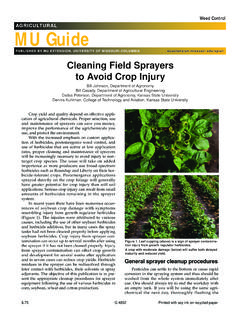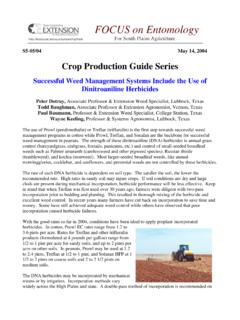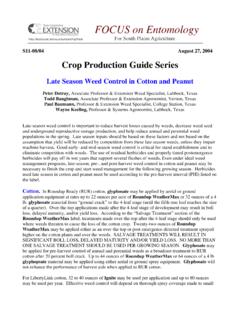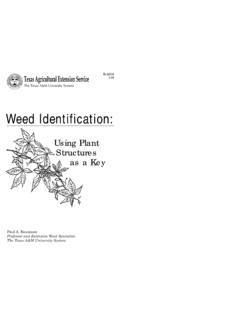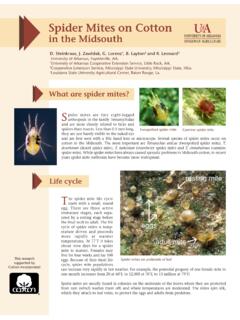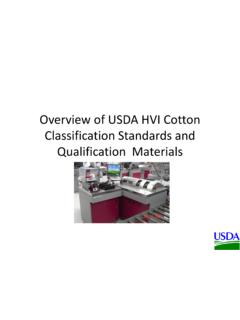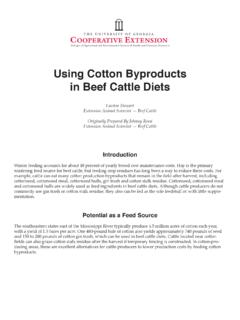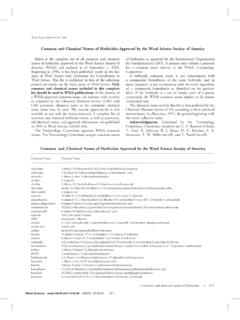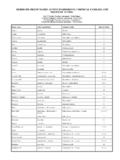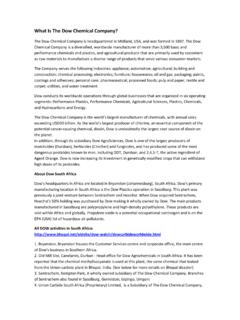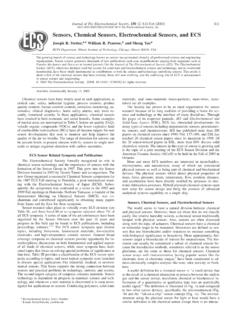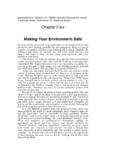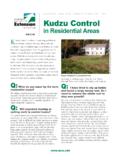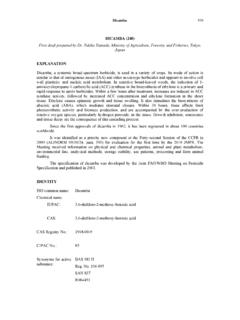Transcription of LibertyLink® Cotton System
1 SCS-2004-02. libertylink Cotton System Robert Lemon, Todd Baughman, Randy Boman, Peter Dotray and Paul Baumann*. The libertylink Cotton System is a new transgenic, of spray additive or ammonium sulfate. However, for larger postemergence herbicide management System for Cotton weeds or when weeds are under stress, the addition of developed by Bayer CropScience. libertylink Cotton ammonium sulfate may improve control. varieties marketed by FiberMax have a genetically based resistance to Ignite herbicide (also called Liberty , Fi- Unlike the current Roundup Ready System , Ignite appli- nale and Rely ). Ignite can be used over-the-top of cations should be based on the size of the target weeds, Cotton up to 70 days prior to harvest.
2 Essentially, that not the size or growth stage of the Cotton crop. Research means that postemergence applications of Ignite can be conducted in Texas and across the Cotton Belt has shown made up to the early bloom period. Use rates will be 32 that for optimum control Ignite should be applied to weeds to 40 , not to exceed 80 oz. per season. while they are small. Generally, weeds should be no larger than two to four inches tall at application time (consult the The chemical name for Ignite is glufosinate ammonium, but label for specific weed recommendations). do not get that confused with glyphosate, the chemical name for RoundupWeathermax , Touchdown , and numerous Similar to all herbicides, Ignite has strengths and weak- generic products.
3 These are very different herbicides and nesses. One of the strengths is morningglory and cockle- libertylink and Roundup Ready Cotton varieties are not bur control, while one of its weaknesses is pigweed and interchangeable. In other words, you cannot spray grass control. Most morningglory species can be treated glyphosate products over the top of Liberty Link va- up to 6 inches in size, but sharppod morningglory (a pe- rieties, and you cannot spray Ignite over-the-top of rennial) should be treated when two inches tall and repeat Roundup Ready varieties, or the result will be dead applications will be necessary. Also, pigweed species Cotton plants. should be treated when very small for optimum control (one to three inches tall).
4 Most grasses should be treated Ignite is a non-selective contact herbicide that has activity when three to six inches in height, but regrowth may oc- on both grasses and broadleaf weeds, but its strength is cur. annual broadleaf weeds. It has no soil activity and translo- cation within the plant is limited. Therefore, thorough cov- Results from Ignite weed management studies conducted erage is essential. A spray volume of 15 gal/acre and use in Texas have shown that the best strategy for season-long of flat fan, extended range flat fan, and Turbo Teejet type weed control is to utilize a tandem approach, consisting of nozzles are recommended. Plants show chlorosis and a residual soil applied herbicide(s) followed by early- and/.
5 Wilting within three to five days after application. The re- or mid-postemergence applications of Ignite (as dictated sistant Cotton varieties possess an enzyme that converts by weed pressure). This tandem approach provides the the herbicide to a non-phytotoxic compound. Results from best scenario for maintaining a weed-free situation during several years of testing across the Cotton Belt indicate the initial four to eight weeks after planting (the time pe- that libertylink Cotton varieties are totally resistant to the riod when weed interference is most detrimental to crop herbicide. Ignite does not require the addition of any type productivity) and for season-long control.
6 *Professor & Extension Agronomist- Cotton , College Station, TX; Associate Professor & Extension Agronomist, Vernon, TX; Associate Professor & Extension Agronomist- Cotton , Lubbock, TX; Associate Professor of Weed Science & Extension Weed Specialist, Texas Tech University &Texas Cooperative Extension, Lubbock, TX; & Professor & Extension Weed Specialist, College Station, TX. Several libertylink varieties are available this season. with most new technologies, we still have much to learn. These include the picker varieties FiberMax 981LL However, our research to this point indicates that when (FiberMax 989 background), FiberMax 832LL (FiberMax used properly this new transgenic herbicide System should 832 background), FiberMax 966LL (FiberMax 966 back- provide another viable option for managing weed pests.)
7 Ground), FiberMax 958LL (FiberMax 958 background), Remember, for best results follow label recommendations and the stripper variety FiberMax 5035LL. on optimum weed size at application and use a carrier vol- ume of at least 15 gallons of water. This will be the initial season to evaluate the Ignite/. libertylink System on a commercial field-scale basis. As TM. Produced by SCS Communications The Texas A&M University System Additional publications may be viewed at: The information given herein is for educational purposes only. Reference to commercial products or trade names is made with the understanding that no discrimination is intended and no endorsement by Texas Cooperative Extension and Texas A&M University is implied.
8 Educational programs conducted by Texas Cooperative Extension are open to all people without regard to race, color, sex, disability, religion, age, or national origin. Issued in furtherance of Cooperative Extension Work in Agriculture and Home Economics, Acts of Congress of May 8, 1914, as amended, and June 30, 1914, in cooperation with the United States Department of Agriculture. Chester P. Fehlis, Director, Texas Cooperative Extension, The Texas A&M University System .
